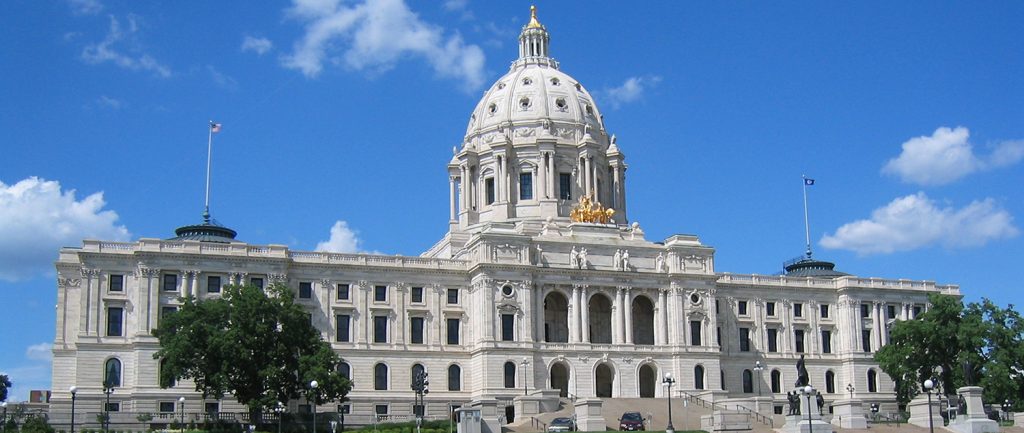Overview
Election night surprised many, as the unexpected Trump wave that started on the East Coast rolled through the Midwest, and although Democrat Hillary Clinton narrowly won Minnesota (with 46 percent of the vote to Trump’s 45 percent), Trump performed well in the traditionally blue state. Nineteen of Minnesota’s 87 counties that voted for President Barack Obama in 2012 voted for Trump last week, shifting about 50,000 votes and that effect was felt on Minnesota’s political landscape.
After the votes had been counted, Minnesota Republicans walked away with a 76-57 seat majority in the Minnesota House of Representatives (up from 73 seats in the last term) and Senate Republicans surprised everyone and pending a couple of recounts in narrow races, are expected to hold a one-seat majority in the chamber (34-33).
The battle for the legislature was fought in small rural towns, regional centers and the metropolitan suburbs. The Trump effect certainly had an impact on legislative races, but the unhappiness among voters over big increases in health coverage costs for people who buy insurance on the individual market, a byproduct of the federal Affordable Care Act, may have been a tipping point that had a significant impact on Minnesota legislative races.
MN House
Minnesota House Republicans held a 12-seat advantage over DFLers (73-61) before Election Day. House DFLers needed to gain 7 seats to win majority control. Those DFL pick ups did not occur, as the GOP maintained their majority in the House by winning and flipping 4 metro area DFL seats and by the end of it all, increasing the GOP majority by 3 seats. Key House DFL losses include: John Persell (5A), Tom Anzelc (5B), Ron Earhardt (49A), Barb Yarusso (42A), Open Seat formerly held by Joe Atkins (54A), Open Seat formerly held by Dan Schoen (54B). House Republicans lost the Open Seats, formerly held by Tara Mack (57A) and Chad Anderson (50B).
A Special Election will take place on Feb. 14, 2017 in House District 32B, where the courts ruled earlier this year that GOP Rep. Bob Barrett didn’t technically live in the district. House GOP is favored to retain the seat – the district leans heavily Republican.
History was also made on election night in the House of Representatives – District 60B (Cedar-Riverside, SE Minneapolis and the University of Minnesota) elected Ilhan Omar, who will become the nation’s first Somali-American legislator.
MN Senate
Senate Republicans surprised everyone and flipped the chamber by one seat, 34-33, toppling several senior DFL senators in rural Minnesota to get there. In the 2011-2012 session, they controlled the Senate for the first time in nearly 40 years. DFLers went into this last election with a 10-seat advantage. Seats flipped by Senate Republicans: Open Seat formerly held by LeRoy Stumpf (SD1), Rod Skoe (SD2), Lyle Koenen (SD17), Tom Saxhaug (SD5), Kevin Dahle (SD20), Matt Schmit (SD21), Vicki Jensen (SD24), Open Seat formerly held by Terri Bonoff (SD44). Senate DFLers claimed victories in the Open Seat formerly held by David Thompson (SD58) and (SD 48) where Senate Minority Leader David Hann lost his reelection bid.
A Roadblock
Republican legislative majorities still have one major roadblock to their agenda in Saint Paul – DFL Governor Mark Dayton. He’s still in office for the next two years, and he knows what it’s like to go head-to-head with an all GOP legislature. The governor’s first two years in office (2011-2012) were opposite a GOP House and Senate.
The 2017 Legislative Session convenes on Tuesday, Jan. 3, 2017.
Leadership
House and Senate Caucus members have elected their respective leaders:
Senate GOP:
Majority Leader – Paul Gazelka (R-Nisswa)
President – Michelle Fischbach (R-Paynesville)
Senate DFL:
Minority Leader – Tom Bakk (D-Cook)
House GOP:
Speaker – Kurt Daudt (R-Zimmerman)
Majority Leader – Joyce Peppin (R-Rogers)
House DFL:
Minority Leader – Melissa Hortman (D-Brooklyn Park)
In the coming days and weeks, House and Senate majority caucuses will be naming committee chairs and membership.
Congress
Minnesotans also witnessed competitive congressional races, as 3 U.S. House races in Minnesota were some of the most closely-watched in the nation. None of Minnesota’s 8 seats flipped political parties.
The 8th Congressional District rematch between incumbent DFL Rep. Rick Nolan and challenger GOP Stewart Mills was one of the most competitive and most expensive U.S. House races in the country. Nolan prevailed – again. Republicans had hoped support for Trump in the district would lift Mills in the historically DFL district.
In the 3rd Congressional District, DFLers worked hard to tie incumbent U.S. Rep. Erik Paulsen to Trump. But he was able to comfortably defeat DFL challenger Terri Bonoff.
Congressman Tim Walz will return to Washington to represent Minnesota’s 1st Congressional District, but the outcome of Tuesday’s election was just about as close as possible. The former teacher from Mankato eked out a win over GOP challenger Jim Hagedorn of Blue Earth. Walz captured 169,080 votes – just over 50 percent of the total vote share. Hagedorn got 166,533 votes – nearly 50 percent.
Republican Tom Emmer easily won re-election, as did DFL U.S. Reps. Betty McCollum, Keith Ellison and Collin Peterson.
Stay tuned throughout the next legislative session for updates from the Capitol.



